rohs符合性声明模板英文
Introduction
ROHS (Restriction of Hazardous Substances) compliance is a vital aspect of electronic manufacturing. As an SEO editor in the field, I have seen how important it is for manufacturers to have an ROHS compliance statement to create more brand trust while maintaining safe and environmentally friendly standard practices. This article will discuss the essential components of an ROHS compliance statement and how manufacturers can apply it to their products.
Why is ROHS Compliance Important?
The ROHS directive restricts the use of specific hazardous substances commonly found in electronic and electrical products, such as lead, cadmium, and mercury. These substances are harmful to both the environment and human health, contributing to soil and water pollution, as well as long-term medical conditions such as cancer and birth defects.
ROHS compliance ensures that manufacturing companies maintain responsible environmental practices and provide safer, more sustainable products to consumers. Complying with ROHS regulations guarantees that a manufacturer meets these standards, creating a positive public image.
Essential Components of an ROHS Compliance Statement
An ROHS compliance statement should have four essential components, clearly explaining the process and summary of the assurance:
Identification of the Product Covered by the Statement:
This component specifies the product name, model number, and where applicable, a serial number or accessory identification. It should also include the date of the product's production or manufacturing for reference purposes.
Statement of ROHS Compliance:
The statement of ROHS compliance should explicitly state that the product fully complies with the ROHS directive. It should also declare that the product meets the requirements of any applicable ROHS instruction or regulation.
Description of the Production Process:
The description of the production process must provide relevant information about the manufacturing process and control measures implemented to ensure the ROHS compliance of the products. It should give details such as the methods used for monitoring the hazardous substance limits, and steps taken to eliminate the prohibited substances within the product and manufacturing process.
Identification of the Party Responsible for Compliance:
The identification of the responsible party tells potential customers who is in charge of ensuring that the product complies. This section should include contact information so that customers can reach out with any inquiries.
How to Best Apply ROHS Compliance to Products
To ensure that products meet ROHS compliance standards, manufacturers must take a few steps:
Invest In Risk Assessment
Manufacturers need to conduct necessary risk assessment to ensure the safety of their products. By doing this, all the potential risks are identified, classified, and must meet the ROHS directive’s compliance criteria.
Choose Appropriate Materials and Manufacturing Processes
Manufacturers should use materials and processes that eliminate the use of prohibited substances. Use of ROHS compatible materials and processes is essential to ensure that products meet ROHS requirements.
Have a Strategic Compliance Plan
During all stages of production, it is important to have a compliance plan to consistently meet ROHS requirements. Manufacturers should continually monitor, test, and verify product compliance to maintain high levels of assurance.
Work with Accredited Testing Labs
Working with ROHS testing labs that are ISO accredited and reputable helps ensure products meet compliance standards. Manufacturers should collaborate with these labs to conduct essential tests such as chemical testing, mechanical testing, and electric safety testing.
Conclusion
ROHS compliance is crucial for electronic manufacturing, ensuring that products are created sustainably and are environmentally friendly. By including the essential components of an ROHS compliance statement, manufacturers can convey their commitment to compliance and safety practices to the public. Complying with ROHS standards decreases the use of harmful substances and improves product quality, reducing the risk posed to users' health and the environment.


 有样品要送检?试试一键送检,15分钟极速响应
有样品要送检?试试一键送检,15分钟极速响应



